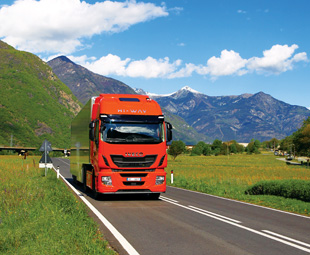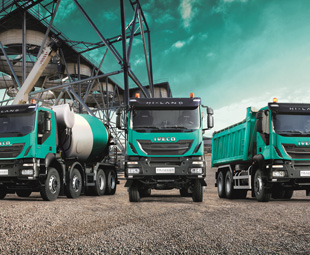New Stralis is the Truck of the Year!

In his monthly review of global news for local truckers, FRANK BEETON takes a look at Iveco’s new Stralis Hi-Way, recently named as the 2013 International Truck of the Year, ponders on the potential of DAF’s XF105 to usurp Kenworth’s long-running domination of the Aussie “heavy” segment, and notes progress in the Chinese engine joint venture entered into between Navistar and JAC.
Last month, GLOBAL FOCUS expressed the opinion that the imminent implementation of Euro-6 emission standards in January 2013, and the recent staging of the biennial IAA show in Hanover, would produce a raft of new European product activity, and this has proved to be an accurate prediction. After reporting in detail on the new Volvo FH Series in our previous column, we bring you news of another significant new product in the form of the Iveco Stralis Hi-Way, which has been awarded the title of 2013 International Truck of the Year. In gaining this accolade, the new Stralis beat off challenges from the Mercedes-Benz Antos, Ford Otosan’s new Cargo from Turkey, and Mitsubishi’s Canter 4×4, which was recently launched on to the European market.
Late last year, we reported on Iveco’s announcement that it could, contrary to normal industry methodology, achieve Euro-6 compliance without resorting to the employment of exhaust gas recirculation (EGR) technology. To do this, Iveco’s engine building sibling in the Fiat Industrial Group, Fiat Powertrain Technologies (FPT), developed HI-eSCR (high efficiency selective catalytic reduction) technology, which is claimed to achieve a nitrogen oxide (NOx) conversion efficiency of more than 95 percent, about 10 percent better than previous industry best practice. The philosophy behind this solution was to concentrate on optimising the engine’s fuel economy, keeping particulate matter emissions at low levels and leaving an enhanced SCR process to deal with the NOx emissions.
The new Stralis Hi-Way employs this technology to achieve Euro-6 compliance, using the newly introduced 8,7-litre Cursor 9 and 11,1-litre Cursor 11 engines, together with a 13-litre derivative for maximum performance, while previous generation 8-, 10- and 13-litre versions have been retained for markets where Euro-5 standards are still acceptable. Power outputs of these six-cylinder in-line diesels range from 230 kW to 420 kW (310 hp to 560 hp), and there are also compressed natural gas-fuelled alternatives covering the output spectrum from 200 to 250 kW (270 to 330 hp). The Euro-6 engines have additional features in the form of a more efficient Super Engine Brake, which adds an exhaust throttle valve to the earlier decompression brake, a common-rail fuel injection system working at pressures up to 2 200 bar, variable geometry turbochargers, and a new electronic control unit that manages engine parameters and the exhaust after-treatment system.
Driveline options include the first reported application, from 2014, of ZF’s new TraXon automated transmission (see FOCUS October 2012), which is likely to carry unique Iveco branding as applied to the current Eurotronic version of ZF’s AS Tronic 12-speed gearbox. There are also nine- or 16-speed manual change units, or a six-speed Allison torque converter automatic. Three and four axle configurations are available. Drive axle choices include single reduction, double reduction and single or multiple differential lock units, while front axles with permissible imposed loads of up to nine tonnes are offered. Suspension choices in the Stralis catalogue include full-air, a combination of rear air and front mechanical, or all-steel, with the latter two systems employing parabolic leaf springs as their mechanical elements.
The absence of EGR from the engine specification has negated the need for additional cooling airflow requirements, and made possible the carrying over of the previous generation basic cab structure, but frontal restyling has improved its aerodynamic performance, as well as giving the new Stralis generation a distinctive appearance. The standard Hi-Way long haul cab width is 2 500 mm in high- and low-roof sleeper configurations, but there are also narrower 2 300 mm Hi-Road sleeper and Hi-Street day cab versions for more localised operations. The electronic feature list includes electronic braking system with brake assistant, lane departure warning, electronic stability programme, adaptive cruise control, daytime running lights, driver attention support, and advanced emergency braking system. Operational monitoring, communication and entertainment functions are grouped together in “Iveconnect”, an exclusive telematics system that now also incorporates “Driving Style Evaluation”, which displays feedback to the driver on the seven-inch touchscreen and provides suggestions for a more fuel-efficient driving technique.
 The world premiere of the new Trakker construction range was also staged at the Hanover show. This should hold considerable interest to operators in South Africa, where the Trakker line-up makes up a significant proportion of this manufacturer’s participation in the local extra-heavy commercial vehicle (EHCV) market segment. Using a similar cab design to the new Stralis models, the latest Trakker employs the Euro 5-compliant eight- and 13-litre displacement versions of the Cursor engine line-up. Iveco has announced that it’s closing five European plants in order to create greater efficiency in its operations, and will be consolidating production of its Stralis heavy truck series in Madrid, Spain. The Ulm plant in Germany, which currently also produces Stralis models, will in future be utilised for fire truck and appliance production, resulting in the closure of smaller plants in Chambery (France), Graz (Austria), and Welswell/Goerlitz (Germany). Euro 5-level Stralis Hi-Way production has already commenced, and will be followed by Euro 6-compliant models in January 2013.
The world premiere of the new Trakker construction range was also staged at the Hanover show. This should hold considerable interest to operators in South Africa, where the Trakker line-up makes up a significant proportion of this manufacturer’s participation in the local extra-heavy commercial vehicle (EHCV) market segment. Using a similar cab design to the new Stralis models, the latest Trakker employs the Euro 5-compliant eight- and 13-litre displacement versions of the Cursor engine line-up. Iveco has announced that it’s closing five European plants in order to create greater efficiency in its operations, and will be consolidating production of its Stralis heavy truck series in Madrid, Spain. The Ulm plant in Germany, which currently also produces Stralis models, will in future be utilised for fire truck and appliance production, resulting in the closure of smaller plants in Chambery (France), Graz (Austria), and Welswell/Goerlitz (Germany). Euro 5-level Stralis Hi-Way production has already commenced, and will be followed by Euro 6-compliant models in January 2013.
Can DAF conquer Australia?
The two most enduring characteristics of the Australian truck market in recent times have been Isuzu’s 23-year run as the top-selling brand in the overall market above 3 500 kg gross vehicle mass (GVM), and Paccar group company Kenworth’s decade-long domination of the heavy commercial vehicle (HCV) segment, where GVM ratings exceed 15 tonnes. Back in 2010, GLOBAL FOCUS examined Kenworth’s efforts, through its upcoming 2011 product range, to safeguard its position Down Under, where much of its success had been due to local manufacture of unique models, incorporating preferences for American driveline aggregates, while also conforming to unique operating requirements and the regulatory environment. This successful strategy was most clearly illustrated by the continuing evolution of K-Series cab-over (forward control) models since Australian assembly first began in 1971, despite the almost total absence of US home market demand for this configuration.
 This success has not been without significant challenges from the likes of the Daimler Trucks Group, which, after not achieving the desired level of local heavy duty market success with European product offerings, has aggressively positioned its American-sourced Freightliner products to capture an increased share of Australian business. Freightliner products fit well with Australian preferences, and the latest version of the Argosy cab-over has been fine-tuned to enhance its suitability for length-sensitive “B Double” applications. However, the increased emphasis being placed by global manufacturers on vertical product integration using in-house driveline components may result in greater competitiveness for Eurocentric products Down Under, and the most serious future threat to Kenworth’s position may, in fact, come from within the Paccar group itself.
This success has not been without significant challenges from the likes of the Daimler Trucks Group, which, after not achieving the desired level of local heavy duty market success with European product offerings, has aggressively positioned its American-sourced Freightliner products to capture an increased share of Australian business. Freightliner products fit well with Australian preferences, and the latest version of the Argosy cab-over has been fine-tuned to enhance its suitability for length-sensitive “B Double” applications. However, the increased emphasis being placed by global manufacturers on vertical product integration using in-house driveline components may result in greater competitiveness for Eurocentric products Down Under, and the most serious future threat to Kenworth’s position may, in fact, come from within the Paccar group itself.
It’s not only in North America that global manufacturers have been trying to wean truck operators off the traditional “kit truck” concept, beloved of many. At this year’s Melbourne Truck Show, Paccar launched its DAF XF105 “thoroughbred” into the Australian market, and has more recently added a version fitted with an 18-speed Eaton Roadranger manual shift transmission as an optional alternative to the more usual ZF Astronic automated gearbox fitment. The really important feature of the XF105 in this context, however, is its Paccar group MX 12,9-litre power plant, originally developed by DAF in Europe, but now also manufactured, and sold in increasing quantities, by the group in the United States. The Australian XF execution has an output of 375 kW (510 hp) and a torque rating of 2 500 Nm. All other things being equal, there should be important benefits for Paccar in selling these trucks in Australia, in terms of first-off profitability, and subsequent parts and service revenue, than could be derived from Kenworths fitted with Cummins engines and other bought-in driveline aggregates. Current rumour has it that a Kenworth T403 conventional, fitted with the MX engine, is under test in Australia to fully evaluate the power plant in a Kenworth installation.
The other important consideration is the age of Kenworth’s K-Series cab-over product platform, which has been continuously developed to provide the Australian B-Double market segment with the product it needs. The K-Series has been around for about half a century, which suggests that it will need more than progressive upgrades to keep it competitive into the future. There is negligible demand for cab-over line haul product in North America, and the Australian market, similar in size to South Africa’s, is unlikely to provide the critical mass necessary to financially justify comprehensive development of a unique product. The same challenge is expected to eventually face the considerably newer Freightliner Argosy, but its manufacturer, like Paccar, does have access to European-sourced cab-over product, and, with the progressive adoption of universal global drivelines now the apparent strategy being employed by both groups, it seems reasonable to expect that Eurocentric products will eventually be called upon to cover the Australian market requirement.
This situation is sure to result in much agonising within Paccar’s Australian boardroom in years to come. While logic appears to be firmly on the side of increased emphasis being placed on the DAF product in Australia, there will be a strong counter argument that says: “If it isn’t broken, don’t fix it!” The Kenworth brand has been built up over many years by providing the product and levels of support demanded by Australian customers, and its long-standing dominant position in this most challenging of market segments is testament to its success. The brand has accumulated enormous value, and it will take extreme marketing courage to walk away from it. However, economics is sure to be a powerful persuader, and it will be very interesting to see how the change in direction is managed, should it become inevitable.
The Navistar-JAC engine joint venture
In previous GLOBAL FOCUS columns, we have explained the importance of diesel engine manufacture to Navistar International Corporation’s global business. While the present company and its predecessors claim to have built more than 15 million engines during their corporate history, current diesel manufacturing operations are located in Huntsville (Alabama) and Melrose Park (Illinois) in the USA, Santo Amaro (São Paulo, Brazil), Canoas (Rio Grande do Sul, Brazil), Jesus Maria (Córdoba, Argentina) and Pune (India). The engine range covers displacements from 2,8 to 15 litres, and these MaxxForce and MWM International-branded engines can be found fitted to the group’s own in-house products, as well as those of numerous client manufacturers and various agricultural, industrial, defence and stationary power applications.
Recognising the growing importance of China as a market and manufacturing base for both trucks and engines, Navistar signed a joint venture agreement with Anhui Jianghuai Automobile Company (JAC) in September 2010 to develop, build and market advanced commercial diesel engines in that country. Since then, Navistar has established offices in Shanghai, Beijing and Hefei, and started construction on a 93 000 m2 manufacturing plant in Hefei in anticipation of Chinese regulatory approval of the joint venture. This was forthcoming in August 2012, allowing plans to proceed for the local manufacture of Euro 5-compliant MaxxForce 3,2- and 7,2-litre engines, as well as JAC’s own 2,8-litre HFC4DA1 diesel.
It has been stated that this operation will support global export opportunities for JAC’s light, medium and heavy commercial trucks, and letters of intent have already been signed to involve Navistar’s dealers in Mexico and Brazil in activities related to these vehicles. However, it is notable that the JAC J45, J65 and J75 trucks recently introduced to the Australian market are powered by Chinese-built Cummins ISF engines of 2,8- and 3,8-litre capacity. Presumably, plans will be in place to replace these power units with Navistar-JAC diesels once these become freely available. It is also expected that the joint venture will extend to the Chinese production of trucks, although the two parties are still in negotiations to finalise procedures and agreements before the process of seeking government approval for the expanded arrangement will
be initiated.
Interestingly, the Chinese Ministry of Industry and Information has announced a Qualification Withdrawal System, which will prevent under-performing vehicle manufacturers from seeking test and certification approval for any new model launches.
The minimum criteria to be applied are:
• Large and medium-sized bus and coach manufacturers must sell more than 50 units per annum for two successive years;
• Light-duty bus manufacturers must sell more than 100 units per annum for two successive years;
• Medium and heavy truck manufacturers must sell more than 50 units per annum for two successive years;
• Light duty truck manufacturers must sell more than 500 units per annum for two successive years; and
• Special-purpose truck manufacturers must sell more than 100 units per annum for two successive years.
These measures are intended to eliminate very small manufacturers from the industry, or, at least encourage their absorption into larger, more successful entities. However, there is a concern that the published criteria, which focus entirely on business scale, and ignore quality and financial efficiency, may work against privately-owned operations, to the ultimate benefit of the larger, state-owned companies.
Global FOCUS is a monthly update of international news relating to the commercial vehicle industry. It is compiled exclusively for FOCUS by Frank Beeton of Econometrix.
Published by
Focus on Transport
focusmagsa



 !
Starting 1 April, every
!
Starting 1 April, every


 FUSO: Driving the Future of Mobile Healthc
FUSO: Driving the Future of Mobile Healthc



 A brand
A brand




 Wondering about the maximum legal load for a
Wondering about the maximum legal load for a 
 The MAN hTGX powered by a hydrogen combus
The MAN hTGX powered by a hydrogen combus


 Exciting News for South African Operators
Exciting News for South African Operators





